Test drive: 2022 Hyundai Santa Fe plug-in hybrid hits at home, misses on the highway
The 2022 Hyundai Santa Fe plug-in hybrid is easy to overlook in the paradigm shift from internal-combustion engines to full battery electric vehicles. A bridge spans these two automotive eras, and Hyundai has a representative on both sides. In addition to a gas-powered Santa Fe, there is a Santa Fe hybrid, and, on the electric side, a Santa Fe plug-in hybrid.
The differences can be confusing, even as Hyundai, Kia, Toyota, Lexus, Volvo, Jeep, Chrysler, Ford, Lincoln, BMW, Audi, Porsche, and Mitsubishi introduce more PHEV versions. Shoppers are starting to notice. PHEV sales doubled from 2020 to 2021, though the number of sales of full battery electrics and hybrids rose even more.
The benefit of plug-in hybrids such as the Hyundai Santa Fe and Hyundai Tucson is you can drive around town without ever using the gas engine, and you can go on long road trips without having to worry about charging it.
This was the case in a Labor Day road trip in the 2022 Hyundai Santa FE PHEV Limited. It satisfied both ends of the bridge with a trait once extolled as a virtue: compromise.
Here’s where that compromise benefited the PHEV experience, and where it fell short.
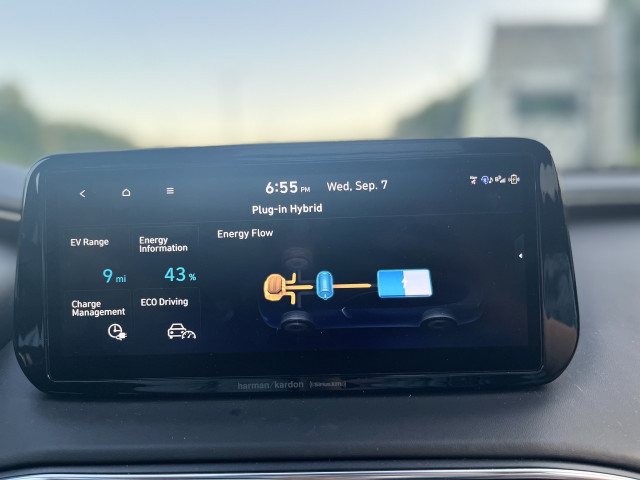
2022 Hyundai Santa Fe PHEV Limited
Hit: Seamless power delivery
The Santa Fe PHEV balances power from its 1.6-liter turbo-4 gas engine and 66.9-kw motor without much notice, unless you’re checking out the power delivery display in the 12.3-inch instrument cluster. A 13.8-kwh battery feeds the motor, and a 6-speed automatic transmission optimizes the engine efficiency based on the driver inputs. It defaults to all-electric mode until you push hard enough on the throttle to trigger the engine, but even when the turbo-4 kicks on and the system’s total output of 261 hp is reached, the cabin remains quiet.
It’s quicker off the line than Santa Fes that lack the electric burst, but there can be a slight delay if you’re cruising along and need to make a passing move. Switching the dial to Sport mode narrows that gap. Overall, the engine-motor combo offsets the 500-lb weight gain over a similarly equipped gas model, and adds in a lot more versatility in how you want to drive.
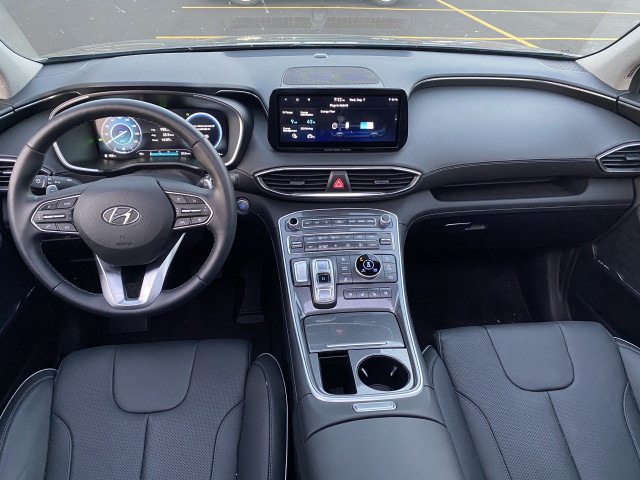
2022 Hyundai Santa Fe PHEV Limited
Miss: Many modes, but no EV hold
The four drive modes are in a console dial with a center button to lock the center differential for even torque between the axles. The all-wheel-drive system is a mechanical one, so the motor alone isn’t powering the rear axle as in other PHEVs. There’s also an EV/Hybrid button beside the dial. It defaults to Eco mode, which operates under electric power until the battery is depleted. The many modes and BEV button allows drivers to customize the powertrain response based on their desired efficiency, or vice versa. For example, in Eco mode with the EV button on, the throttle pedal lacks the firmness of Sport mode.
Despite the several settings, it lacks an EV Hold function, so I couldn’t save any of the EV battery for when I got off the highway and rolled the last few miles into my destinations.
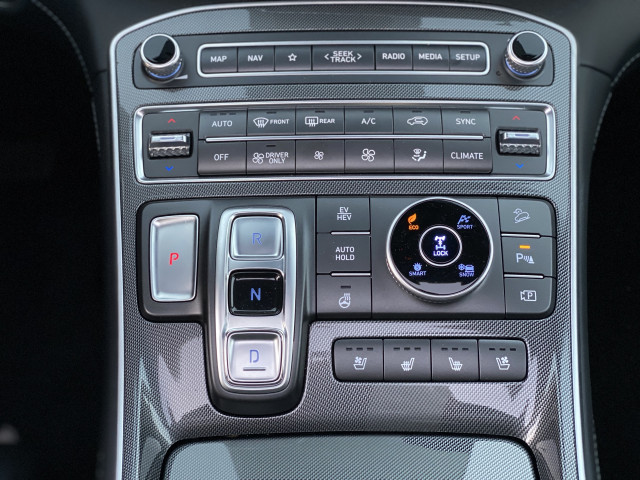
2022 Hyundai Santa Fe PHEV Limited
Hit and Miss: A busy console
Most climate, seat, and drive functions can be found in a busy center console that also houses the electronic gear shifter, touchscreen hot button bar, climate control buttons, heated and cooled seat buttons (in the top Limited trim), and volume and tuning knobs. It’s a lot to take in, but it also limits the reliance on the 10.3-inch touchscreen perched on the dash. I’d rather have real climate buttons and temperature toggles than having to touch the screen.
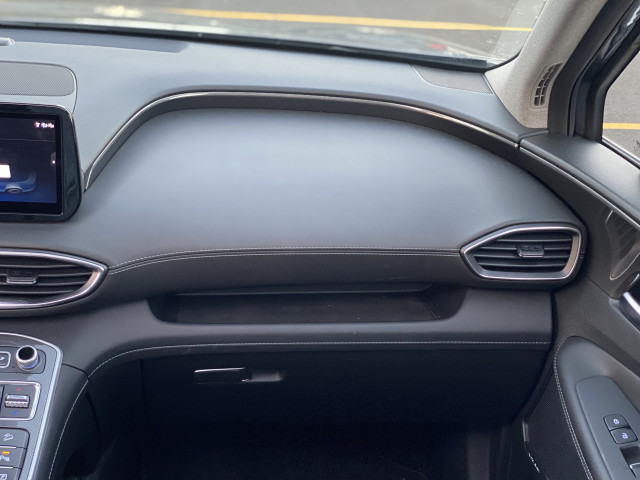
2022 Hyundai Santa Fe PHEV Limited
Hit: Storage shelf above glove box
The Santa Fe PHEV sacrifices about two inches of rear leg room compared to the gas model, down to 39.5 inches, mostly because the battery pack is under the rear seat. That’s really the only sacrifice to interior space, and it’s minor. Hyundai makes up for it with wonderfully clever storage options. My favorite, as well as my various passengers riding shotgun, was a shelf above the glove box perfect for a passenger’s phone, pen, wallet, energy bar, toll transponder, and any number of other items for quick access. It’s tilted up so nothing slides out, and it integrates well with dash trim that arcs from the doors toward the windshield and back to the center screen.

2022 Hyundai Santa Fe Plug-In Hybrid
Hit: 31 miles of electric range
The 31 miles of EV range means it’s a great commuter around town with no tailpipe emissions. Hyundai might be understating its range based on my impressions. The RAV4 PHEV leads the pack with 42 miles of range, but 31 miles is more than enough to handle the daily grind without grinding a drop of gas. And it’s so quiet.

2022 Hyundai Santa Fe PHEV Limited
Miss: Relatively inefficient
The Santa Fe PHEV’s weight gain means it’s not all that efficient on the highway, however. I averaged about 26 mpg on the interstate. The EPA estimates a 33 mpg combined rating without battery power, but the regular Santa Fe Hybrid without a plug has an EPA rating of 33 mpg city, 30 highway, 32 combined.
The Toyota RAV4 Prime, Hyundai Tucson PHEV, and Ford Escape PHEV are more efficient and have more range, but they’re also smaller. The only real mid-size SUV competitors are the six-seat Kia Sorento PHEV and the seven-seat Mitsubishi Outlander PHEV, which both have more range and better hybrid efficiency when the battery is depleted.
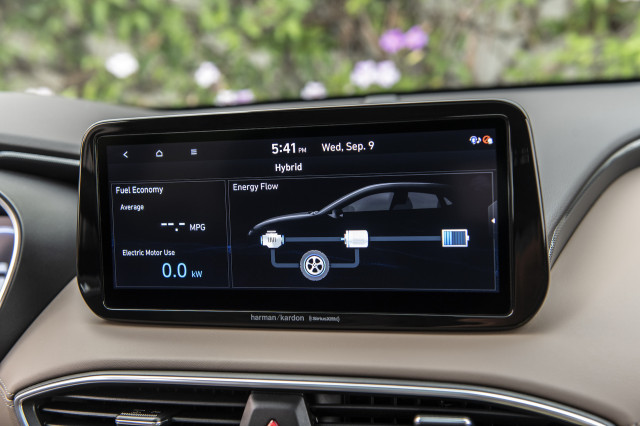
2022 Hyundai Santa Fe
Miss: 12.4 gallon tank
I didn’t have to worry about charging on the road, but I stopped more often than usual to fill up gas due to the Santa Fe PHEV’s small 12.4-gallon tank. For long-distance commuters or frequent road trippers, standard hybrids might be more efficient and convenient.
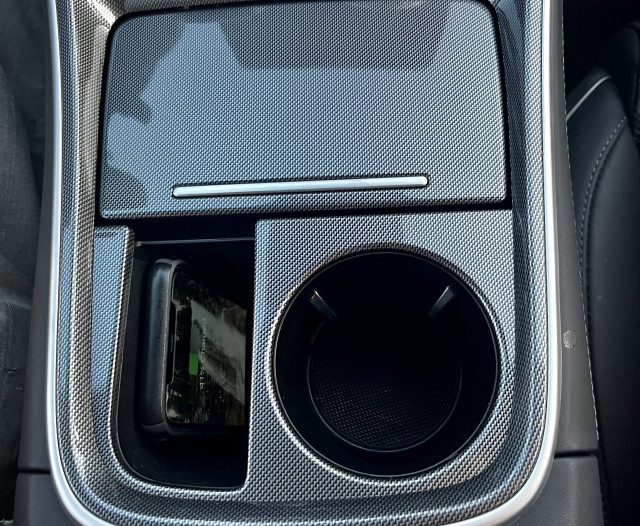
2022 Hyundai Santa Fe PHEV Limited

2022 Hyundai Santa Fe PHEV Limited

2022 Hyundai Santa Fe PHEV Limited
Hit: Smartest smartphone charger yet
Another simple but brilliant design element is the wireless smartphone charger the size of a deck of playing cards. In an ashtray-sized slot next to the cupholders in the console is a small mechanical sleeve that accepts the smartphone vertically and charges it against its wall. An orange button indicates the charge is active. It’s seamless to slip it in and start charging, easy to pull in or out, and never gets lost or confused on a sliding pad tucked under the center stack or forgotten under the armrest console. It’s the best wireless phone charger on the market.
Miss: Still no wireless ACP
Despite that innovation, Hyundai still has to contend with the lack of wireless Apple CarPlay/Android Auto with its larger touchscreen. With all this tech on the top Limited trim, the lack of wireless smartphone compatibility becomes even more egregious. A new head unit with that capability has to be around the corner.
The 2022 Hyundai Santa Fe PHEV gives shoppers more choice within the Santa Fe family, which has gas, hybrid, and plug-in options. The PHEV is a great choice for drivers who log most of their miles around town.
––––––––––––––––––––––––––––––––––––––––––
2022 Hyundai Santa Fe Limited Plug-In Hybrid
Base price: $46,585 including $1,225 destination
Price as tested: $46,780
Powertrain: 1.6-liter turbo-4 with a 67-kw motor and 13.8-kwh battery pack, a 6-speed automatic transmission, and all-wheel drive
EPA fuel economy: 33 mpg combined, 76 mpge gas and electric, 31 miles of electric range
The hits: Seamless power delivery, great packaging, great wireless smartphone charger
The misses: Not much more efficient on the highway, still no wireless Apple CarPlay, no EV Hold

